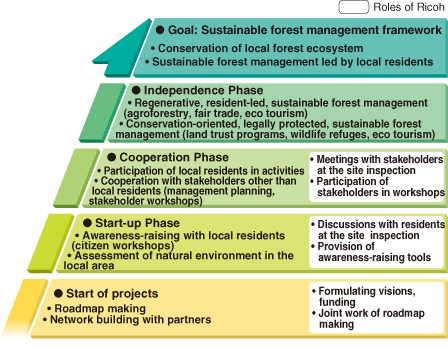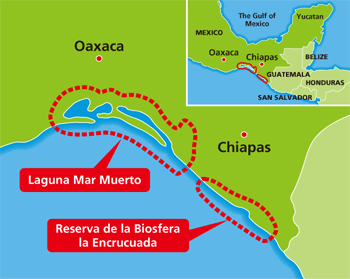- Home
- Sustainability
- Environment
- Conservation of Biodiversity
- Forest conservation projects
Forest conservation projects
There are various habitats for living things on the earth—forests, lakes, coral reefs, and oceans—each of which maintains its own unique ecosystem. If these ecosystems are destroyed, the natural environment necessary to sustain human life will also be destroyed.
Ricoh has given priority to forests, which feature some of the richest ecosystems in terms of biodiversity, and since FY1999, we have been working with environmental NGOs and local communities on various forest conservation projects. Unlike ordinary afforestation undertakings, these activities prioritize protecting the habitats of species indigenous to the land and improving the lives of local residents, with the aim of establishing a framework for sustainable forest management.
Steps to achieve the project goal

Projects implemented in the past
|
Text title |
Project Name |
Country |
Period |
Achievements through activities |
|
|---|---|---|---|---|---|
|
1 |
Restoration of Satoyamat |
Bangladesh POUSH |
Bangladesh |
1999 - 2007 |
|
|
2 |
Forest Conservation and Restoration in World Heritage Areas |
Field Ornithology Group of Sri Lanka (FOGSL) |
Sri Lanka |
2000 - 2007 |
|
|
3 |
Rainforest Restoration |
Conservation Intenational |
Philippines |
2000 – 2010 |
|
|
4 |
Satoyama Conservation, Hino City |
Wild Bird Society of Japan |
Japan |
2000 - 2003 |
|
|
5 |
Tropical forest and orangutan habitat restoration |
WWF |
Malaysia |
2000 - 2010 |
|
|
6 |
Temperate forest and panda habitat |
WWF |
China |
2001 - 2007 |
|
|
7 |
Rainforest Restoration |
Conservation International |
Ghana |
2002 – 2013 |
|
|
8 |
Forest Restoration in the Atlantic Lowland Tropical Forest Boa Nova |
BirdLife International |
Brazil |
2007 – 2015 |
|
|
9 |
Conservation of Taiga, the northern limit habitat of tigers* |
Global Environmental Forum |
Russia |
2004 - 2018 |
|
|
10 |
Biodiversity Conservation of the Sanjiang Parallel Streams World Heritage Site |
Asia Green-Culture Association |
China |
2007 - 2018 |
|
|
11 |
Conservation of Yanbaru Forest |
Yanbaru Forest Trust |
Japan |
2001 – 2019 |
|
|
12 |
Conservation of the Afan Woodland |
C.W. Nicol Afan Woodland Trust |
Japan |
2001 – 2020 |
|
|
13 |
Mangrove Restoration, Malaysia |
BirdLife International |
Malaysia |
2011 – 2020 |
|
|
14 |
Restoration of mangroves in Oaxaca and Chiapas, Mexico |
BirdLife International |
Mexico |
2015 - 2021 |
|
Project for the Conservation of the Afan Woodland in Kurohime, Nagano
~ Improving the self-recovery capability of forests through appropriate human involvement. Creating forests where both indigenous species and humans can live together ~
- Location : Japan (Nagano Prefecture)
- Period : November 2001~ June 2020
- Activity :Treat damaged land and help it recover into natural woodland where the Japanese dormouse (Glirulus japonicus) and other diverse species can live.
The Afan Woodland is a roughly 99,000 square-meter forest in Kurohime, Nagano Prefecture. Once the woodland's ecosystem has been damaged, it is not easy to recover, and it takes hundreds of years for the natural regenerative capabilities to recover on their own, thus it is important for humans to get appropriately involved to help regeneration. With the goal of "Recovering and conserving the stable growth of natural woodland by supporting the natural processes of regeneration over prolonged periods," we have been selecting trees for priority growth and creating an environment where natural regeneration can easily take place. As a result of the activities, it has been confirmed that the number of species of woodland creatures has steadily increased. By imagining what the woodland will look like 100 years from now, we repeatedly "implement activities as planned" and " conduct surveys to verify the effectiveness," while selecting better ways to enhance the forest's regeneration capacity through human involvement.

The symbol of the project: Glirulus japonicus

Afan Woodland at early stage

The Afan Woodland after conservation activities

Shiro Kondo, Ricoh President and CEO (at the time) (left) and C.W. Nicol, chairman of the C.W. Nicol Afan Woodland Trust (right), at the Afan forest
- Partner
C.W.Nicol Afan Woodland Trust

C.W. Nicol Afan Woodland Trust was established in 2002. In purpose of recovering and conserving the Afan Woodland in Kurohime, Nagano Prefecture to create a forest where humans and other animals and plants co-exists, the trust implements ecological research and various academic and conservation activities. Chairman: C. W. Nicol (author, naturist)
Project for the Conservation of Yanbaru Forest
~ By realizing their irreplaceability, forests can be left for future generations. Bequeathing forests that nurture indigenous species ~
- Location:Japan ( Okinawa Prefecture)
- Period :November 2001 - June 2019
- Activity : Maintaining the Yanbaru forest, home to many endangered species, such as the Okinawa rail(Rallus okinawae).
The Yanbaru forest in the northern part of Okinawa is a precious habitat for endemic protected species such as the Okinawa rail and the leaf turtle (Geoemyda japonica). However, the building of dams and the construction of roads through the forest has divided the mountain and negatively impacted the ecosystem.
This project is intended to protect the nature of the Yanbaru Forest by communicating the importance of the forest to local residents and visitors, expanding the circle of people who protect the forest, holding nature observation meetings, and securing trust land. In September 2016, we transformed the area into a national park, which was one of our goals, and we are currently implementing activities to firmly establish nature observations and green tourism.

The symbol of the project: Okinawa rail

View of the Yanbaru forest

Signage in Trust forest

Nature class for children
- Partner
Yanbaru Forest Trust
Through its activities, the trust aims to secure land for wildlife in northern Okinawa Island, which is rich in biodiversity, and to contribute to the promotion of habitats and nature conservation.
Project for the Restoration of Mangrove Forests in the Central Selangor Coast, Malaysia
~Restoring mangrove forests, —a combination of two ecosystems: ocean and forest—to protect habitats for diverse wildlife ~
- Location:Malaysia
- Period:July 2011 – June 2020
- Activity : Restore mangrove forests that serve inherent, ecologically important functions including providing habitats for wildlife, CO₂ absorption, and water retention.
Mangrove forests are some of Malaysia's major ecosystems, supporting an abundance of species. Recently, this natural environment has faced gradual depletion and degradation mainly due to illegal exploitation, including proscribed tree cutting. To address this concern, this project was launched with emphasis placed on the involvement of local communities. The project organizes programs to raise public awareness of the region's major environmental issues and encourages local residents to take proactive actions, such as tree-planting to restore and conserve the precious natural assets of local mangrove forests.

The wetlands are a treasure trove of diverse ecosystems

Mangrove saplings

Smooth-coated otters, which inhabit the region

Tree Planting
- Partner
BirdLife International Tokyo

BirdLife International Tokyo is a Japanese affiliate for BirdLife International, an international environmental NGO headquartered in Cambridge, UK. This Tokyo-based non-governmental organization works closely with its partner organizations in Asia to conserve birds and their habitats in the region as well as contribute to maintaining and improving the natural environment, thereby also promoting the health and wellbeing of people.
Restoration of mangroves in Oaxaca and Chiapas, Mexico
~ Restoring mangrove forests and wetlands to preserve habitats for migratory birds, including endangered species, and sustain the living standards of local residents ~
- Location:South Pacific coastal areas in the states of Oaxaca and Chiapas, Mexico
- Period:July 2015 – June 2021
- Activity: To recover and restore mangrove forests which help preserving a North American migration flyway
Mar Muerto Lagoon and La Encrucijada Biosphere Reserve are in the Mexican states of Oaxaca and Chiapas. Retaining diverse wetland ecosystems stretching along the Pacific coast, these spots provide natural habitats for a wide variety of wildlife, particularly waterfowl, including ducks and geese. Also, situated as they are near the narrowest part of the land area connecting the North and South American continents, these marshy reserves serve as a key stopover point along a principal American migration flyway, offering habitats to many different species of migratory birds, including some on the endangered list. In recent years, these areas have been subject to a range of human activities, from the construction of canals and dikes to aquaculture and salt production. Such activities led to mangrove deforestation, causing aridification and ecological damage in an expanding area across the natural wetlands. Aiming to remedy this situation, Ricoh launched a project in July 2015 in cooperation with local residents and NPOs to recover and restore damaged mangrove forests in pilot zones. This initiative has been designed to help improve the livelihoods of local communities through creating employment opportunities and increasing fishery productivity, as part of planned ecosystem conservation activities.

South Pacific coastal areas in the states of Oaxaca and Chiapas

Workshop for tree planting to local residents

Maintaining mangrove forest

Planting mangrove
- Partner
BirdLife International Tokyo

BirdLife International Tokyo is a Japanese affiliate for BirdLife International, an international environmental NGO headquartered in Cambridge, UK. This Tokyo-based non-governmental organization works closely with its partner organizations in Asia to conserve birds and their habitats in the region as well as contribute to maintaining and improving the natural environment, thereby also promoting the health and wellbeing of people.
